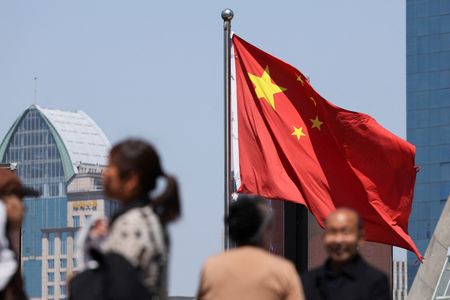(Reuters) -China is taking steps to build a network to sell computing power and curb the unwieldy growth of data centres after thousands of local government-backed centres that sprouted in the country caused a capacity glut and threatened their viability.
The state planner is conducting a nationwide assessment of the sector after a three-year data centre building boom, according to two sources familiar with the matter and a document seen by Reuters.
Beijing is also seeking to set up a national, state-run cloud service for harnessing surplus computing power, according to Chinese government policy advisers. The Ministry of Industry and Information Technology (MIIT) is collaborating with China’s three state telecoms companies on ways to connect the data centres in a network to create a platform that can sell the computing power, they said.
Computing power is a crucial element in the race for technological supremacy between China and the U.S. Besides being an embarrassment for Beijing, unused computing power and financially shaky data centres could hinder China’s ambitions in the development of artificial intelligence capabilities.
“Everything will be handed over to our cloud to perform unified organisation, orchestration, and scheduling capabilities,” Chen Yili, deputy chief engineer at the China Academy of Information and Communications Technology, a think tank affiliated to the industry ministry, told an industry conference in Beijing last month.
Chen did not specify details of the cloud service proposal, but his presentation materials showed China was targeting standardised interconnection of public computing power nationwide by 2028, even as some analysts were skeptical about the plan given the technological challenges it posed.
China Mobile, China Unicom and China Telecom, the state-run telecoms companies, and MIIT did not respond to requests for comment. The sources did not want to be identified because of the sensitivities of the issue.
NATIONWIDE NETWORK
China’s data centre building boom kickstarted in 2022 after Beijing launched an ambitious infrastructure project called “Eastern Data, Western Computing”, aimed at coordinating data centre construction by concentrating facilities in western regions – where energy costs are cheaper – to meet demand from the eastern economic hubs.
Chen said at the June event that the industry ministry has so far licensed at least 7,000 computing centres.
A Reuters review of government procurement documents for data centres used in computing shows a surge last year in state investment, totalling 24.7 billion yuan ($3.4 billion), compared to over 2.4 billion yuan in 2023.
This year, already 12.4 billion yuan has been invested in these centres, most of it in the far-west region of Xinjiang.
But while only 11 such data centre-related projects were cancelled in 2023, over 100 cancellations occurred over the past 18 months, pointing to growing concerns among local governments about returns on their investments.
And utilisation rates are estimated to be low, with four sources putting them at around 20%-30%.
Driven by expectations that government and state-owned firms will act as buyers, investors and local governments tend to build without considering real market needs, said a project manager who works for a server company that provides products for such data centers.
“The idea of building data centers in remote western provinces lacks economic justification in the first place,” said Charlie Chai, an analyst with 86Research, adding lower operating costs had to be viewed against degradation in performance and accessibility.
To regulate the sector’s growth, China’s state planner National Development and Reform Commission (NDRC) initiated a nationwide assessment earlier this year that has already tightened scrutiny of new data center projects planned after March 20, and banned local governments from participating in small-sized computing infrastructure projects.
The NDRC aims to prevent resource wastage by setting specific thresholds – such as requiring a computing power purchase agreement and a minimum utilisation ratio – to filter out unqualified projects, according to a person familiar with the matter, who did not provide details on the thresholds.
NDRC did not respond to a request for comment.
CHALLENGES
Industry sources and Chinese policy advisers said the formation of a computing power network will not be easy, given that the technology for data centers to efficiently transfer the power to users in real-time remains underdeveloped.
When the Chinese government rolled out the Eastern Data, Western Computing project, it targeted a maximum latency of 20 milliseconds by 2025, a threshold necessary for real-time applications such as high-frequency trading and financial services.
However, many facilities, especially those built in the remote western regions, still have not achieved this standard, the project manager said.
Many of the centres also use different chips from Nvidia and local alternatives such as Huawei’s Ascend chips, making it difficult to integrate various AI chips with different hardware and software architectures to create a unified cloud service.
Chen, however, was optimistic, describing a vision of the cloud bridging the differences in underlying computing power and the physical infrastructure.
“Users do not need to worry about what chips are at the bottom layer; they just need to specify their requirements, such as the amount of computing power and network capacity needed,” he said.
($1 = 7.1715 Chinese yuan renminbi)
(Reporting by Reuters staff; Editing by Muralikumar Anantharaman)










